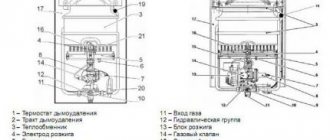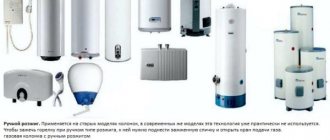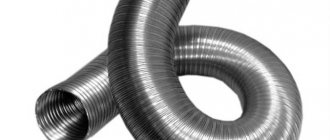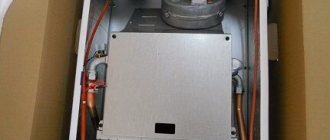Here you will learn:
- Why is there low pressure of hot water in the column?
- How to troubleshoot
- Why doesn't the water heat up?
- Installation of high-quality geysers
- Which geysers operate at low pressure?
- Prevention of scale formation in the heat exchanger
The operating principle of speakers from different manufacturers does not differ significantly. Specifications vary.
By what indicators do the models differ:
- Performance;
- Type of burner;
- Degree of security;
- Ignition method;
- Flue gas removal method.
Classification by ignition type:
- Manual. Found on older models. Most modern manufacturers prefer not to use this type of ignition. To turn it on, you need to light the burner yourself with a match.
- Piezo ignition. To turn on the heater, just press a button. Within a few seconds the water from the tap will be hot.
- Electronic ignition. Allows you to save gas, as the automation turns off and turns on its supply.
Based on the type of burners installed, there are two types of heaters. At constant power, manual temperature adjustment is required. With a variable, automatic adjustment occurs. Modulating burners supply water at a uniform temperature.
Speaker power is one of the main selection criteria. Minimum value -16-19 kW. Maximum – 28-32 kW. A heater with low power will heat up to 10 liters of water per minute. This is not enough for a large family. You can only wash the dishes. Average indicators increase the volume to 20.
In order not to encounter the fact that there is no water pressure in the gas water heater, you should choose trusted manufacturers. The German and Italian companies have gained trust in the market. But there are domestic popular brands. The Neva geyser combines proven quality and an affordable price.
Why did you fall?
The pressure difference at the inlet and outlet of the column should be minimal.
In this case, situations often arise when water barely flows from the heating device. In this case, we can talk about low pressure in the network. Instability of pressure in the pipeline is typical for high-rise buildings. When the pressure of the “incoming” water decreases, the pressure at the outlet decreases.
Here are the reasons for the drop in pressure in the column:

Clogged pipes and filter elements. Particles of iron oxide and lime fall on the filters and are deposited on the internal surfaces of the pipes. Water pressure decreases.- Scale on the heating radiator. Hard water causes plaque to form on the water heating element. A layer of scale may appear not only on the radiator, but also on the tubes through which water exits the column. At the same time, the pressure decreases significantly.
- Clogged plumbing fixture. Occurs most often when the water is turned off frequently. When its supply is resumed, a water hammer occurs, which “delivers” the existing contaminants from the column to the mixer.
- Unit power. When choosing a hot water supply device, you should give preference to models with a power of more than 8 kW.
- At the outlet of the column, pipes with a diameter exceeding 15 mm are installed. Or there are flexible hoses that “reduce” the pressure.
- Old water pipes clogged with rust and plaque.
If the pressure drops to zero, you must stop using the device.
If cold water flows with normal pressure, but comes out of the water heater with less pressure, it is worth checking the unit for serviceability.
There are several reasons affecting its operation:
- Water heater clogged. Rust and scale can get into any component of the unit, which causes a drop in the pressure of hot water with a stable supply of cold water.
- Scale formation in the system. The internal elements are covered with limescale. The pressure decreases, the amount of gas consumed increases.
Blockages and scale can be removed by washing. The main thing is that the work is carried out in compliance with safety regulations.
Operating principle
In atmospheric water heaters, the consumer turns on the forced ignition of the igniter, the flame from which is directed towards the burner. Then he opens the hot water tap, the pressure changes, and under the influence of the membrane the main gas pipeline opens.
Gas begins to flow into the combustion chamber, which is immediately ignited by the igniter. On the front panel there is a control knob with which you can adjust the flame power. In this way, the water is heated, which passes through the coil in the heat exchanger.
The disadvantage of this design is that the pilot wick burns constantly, even when the water heater is not running. If the burner flame goes out for any reason, the combined thermocouple and valve device will shut off the gas supply.
The sensor will work in the same way if there is no draft in the chimney. This operating principle was used on all first brands of geysers. In more modern models, the fuel begins to ignite from the moment the cold water flow starts.
Such devices provide electric ignition , powered by batteries. Forced-air water heaters operate by automatically maintaining the required water temperature.
The burner is started from the electrical network or a hydraulic generator, which generates current when water moves. Further heating control is carried out automatically under the control of sensor readings that regulate the operation of the fan and the combustion process.
How are the reasons for the column and for the boiler different?
Water heating boilers do not have a heating radiator . Water enters the unit, is heated using a heating element and supplied to the consumer. Therefore, the reasons for the drop in pressure are somewhat different from the situation with a gas water heater:

Formation of blockages. Filters are installed at the boiler inlet. If the water is of poor quality, they become clogged with scale and rust particles.- The heating element is covered with scale and salt deposits.
- Corrosion has formed inside the tank and cracks have appeared.
- The pressure regulator is faulty.
- The thermostat has failed. In this case, the water overheats, but does not leave the boiler.
- Faucet (mixer) failure. Blockages can form on the mesh that is installed at the outlet of the tap. If the water heater is in good condition, you should pay attention to the mixers. The problem with pressure can be solved by cleaning the tap filter.
Since the faucet is not part of the water heater, cleaning it yourself will not void your warranty. Therefore, you can clean a clogged mesh yourself, without resorting to the services of specialists.
Malfunctions of the Termet column
Most often, in Thermet devices with electric ignition, it happens that the gas water heater does not ignite. If you do the diagnostics yourself, the first thing you need to do is check the functionality of the batteries. If the geyser does not turn on when you turn on the water, and the spark plug stops clicking, then you need to replace the batteries.
R20 elements are used for devices such as Termet, Dion, Ariston and many others . Experts recommend using alkaloid batteries, as they have a fairly long service life. In Termet speaker designs, batteries are installed in the lower left side.
In semi-automatic water heaters, for example, Termet Termag G 19-01, the ignition nozzle may become clogged, which is why the gas water heater does not turn on. In this case, you should remove the unit casing, check the ignition wires and clean the nozzle. To do this, use soft and thin copper wire.
If after this the water heater starts up poorly or takes a long time, the piezoelectric element will need to be replaced. The unit may also stop working due to violation of the permissible gaps between the electrodes and the wick. To correct this problem, the relevant elements must be adjusted.
How to fix the situation?
If the pressure of hot water in the column decreases, you need to identify the cause and correct it.
Each problem has its own solution:
| Problem | Solution |
| Clogged filter | A mesh filter is installed in the heat exchanger, immediately at the “inlet”. This part can be dismantled, cleaned with an old toothbrush, and rinsed under the pressure of clean water. When cleaning, you may notice damage to the filter. In this case, it is better to replace the mesh with a new one. Otherwise, it will let particles of dirt into the column, which will lead to its failure. |
| Scale formation in the heat exchanger | To remove limescale, you can use aggressive industrial products. They are designed for flushing speaker radiators. Since such compounds are made of acid, cleaning them yourself can lead to failure of the heat exchanger. Therefore, it is better to use folk remedies. For example, a solution of citric acid. |
| Clogged tubes | The difficulty of cleaning lies in starting the reverse flow of cold water. It is necessary to remove the plug, install a basin under the column (where the water will drain), and open both taps. The spout must be clamped with your finger. With good pressure, water moving in the opposite direction will dislodge the blockage. It will pour out along with the water into the substituted container. |
| Faucet failure | Small debris that forms in the gas water heater can reach the mixer. In this case, contamination enters the faucet axle box and the faucet filter. To fix the problem, you need to disassemble the mixer. After dismantling, you need to examine every detail. If necessary, clean or replace with a new one. In some cases, installation of a new faucet is required. |
If the dispenser has warranty service, it is better to entrust the cleaning work to a service technician. Otherwise the owner will lose the warranty.
If problems arise with the water heating boiler, then it is necessary to identify and eliminate the cause:

blockages - clean the filters installed at the entrance to the boiler;- scale on heating elements - clean with citric acid solution or industrial means;
- appearance of cracks on the tank - replacement of equipment;
- malfunction of the pressure regulator and thermostat - replacement;
- blockages of the faucet or its parts - cleaning the faucet axle box, filter.
If there is a significant decrease in water pressure from the boiler, you should stop using it until the problems are resolved.
Installation of high-quality geysers
Poor hot water pressure from a geyser is the main reason for poor quality equipment. Modern boilers are compact devices responsible for heating running water. They are used in houses to which a gas pipeline is connected and there is no centralized hot water supply system.
The equipment in use is divided into flow-through and storage types. Some heat the water as it moves through the system, while others accumulate a certain volume of water in a tank, where it is maintained at a constantly high temperature.
Based on performance characteristics, heaters can be divided into the following subcategories:
- Low-power - heating about 10 liters of water per minute - from 9 to 16 kW.
- An average of 16 to 23 kW gives about 15 liters per minute.
- High-power devices can raise the temperature of 20 liters of water in one minute (over 24 kW).
The performance indicators of low-moisture devices are enough to wash dishes in the kitchen. Medium-power devices are more suitable for two-room apartments. The most high-power boilers can be installed in apartments with 3 rooms or more.
Prevention
If there are problems with water pressure from the water heater, it is necessary not only to eliminate the causes, but also to prevent similar problems from occurring in the future.
Preventive measures will help with this:
- Adjust the temperature and pressure level. Sudden changes in the flow of water into the unit should not be allowed, so as not to provoke detonation. In this case, the specified heating temperature should be sufficient for the selected water pressure.
- Overheating leads to the formation of excess scale and detachment of radiator particles (burnout). Therefore, the water temperature should not exceed 55 degrees.
- Monitor the condition of the filter. The cleaning element is designed to retain salts that damage the surface of the pipes. The filter will also protect the column from small debris contained in the water.
- Installing an electric water softener will help reduce the risk of scale formation.
- If you notice a drop in outlet pressure, immediately contact a specialist. He will check the operation of the column and provide service.
Problems with the water heater or water heating boiler will not arise if preventive measures are taken in a timely manner. The main condition for long-term operation of the units is soft, clean water and the absence of sudden pressure surges.
Everything you need to know about hot water is presented in this section of the site.
Which geysers operate at low pressure?
If the reason for the low pressure of hot water is not in the gas equipment, but in the water pipes, the problem can be solved either by normalizing the pressure in the pipes, or by purchasing a gas water heater that will function properly even with poor water pressure.
Modern geysers, which are equipped with a water pressure control device, can cope with this task. They work according to the following principle: the stronger the water pressure, the higher its temperature, and vice versa. Thus, if you set the minimum water temperature, the column will turn on even with low pressure. However, if problems with hot water pressure are constantly observed, it would be more advisable to equip the system with a pump.












